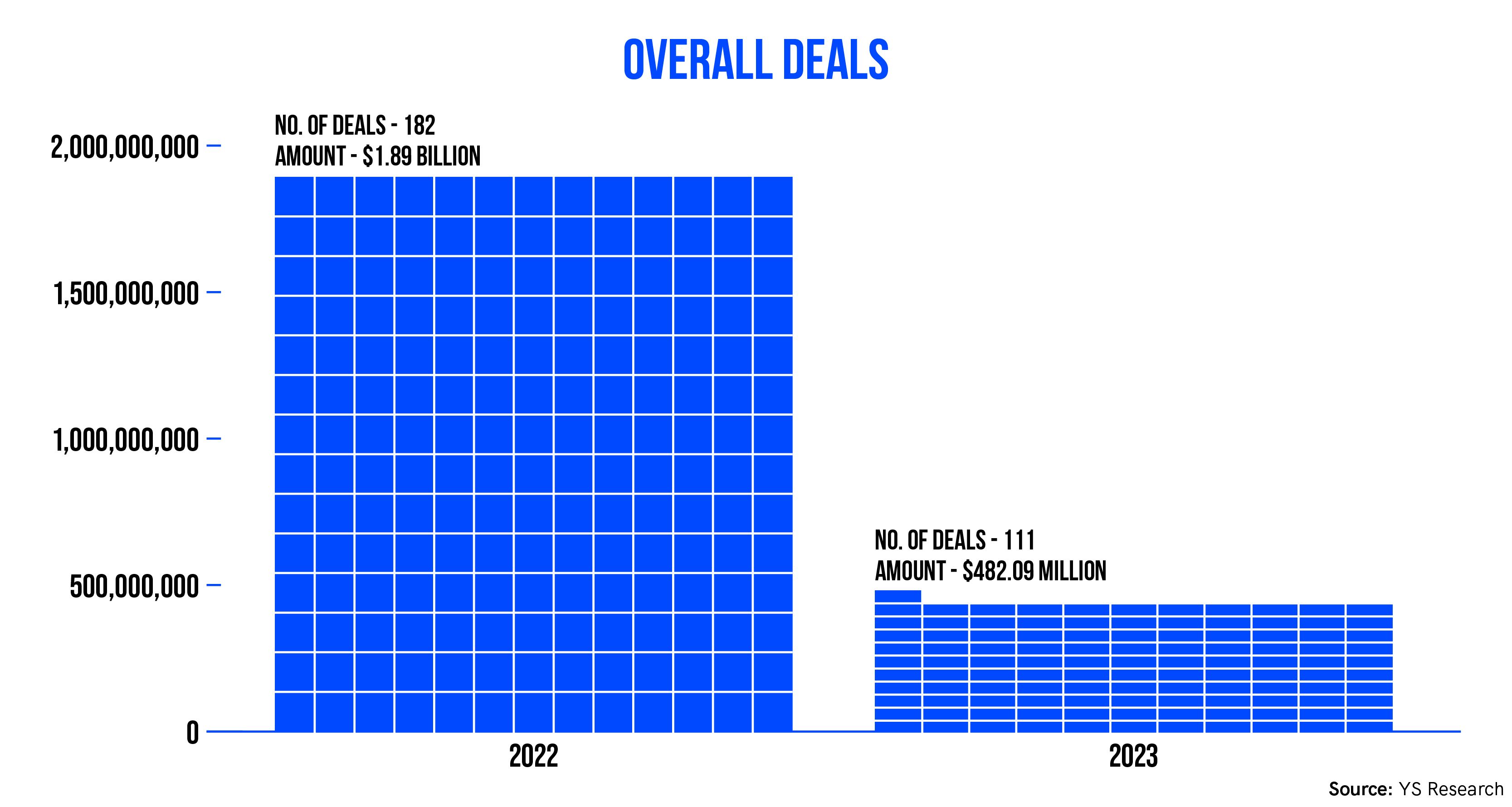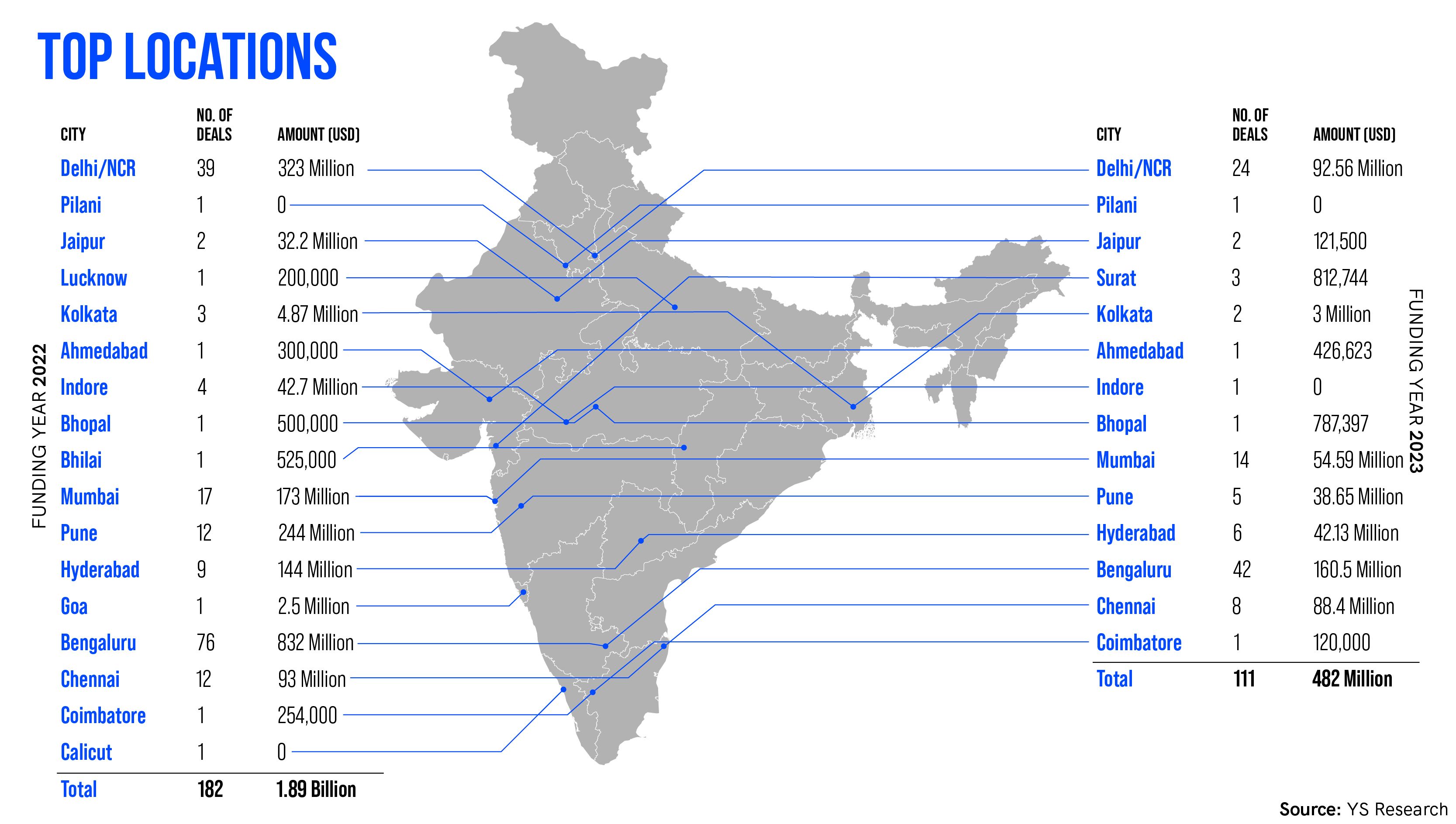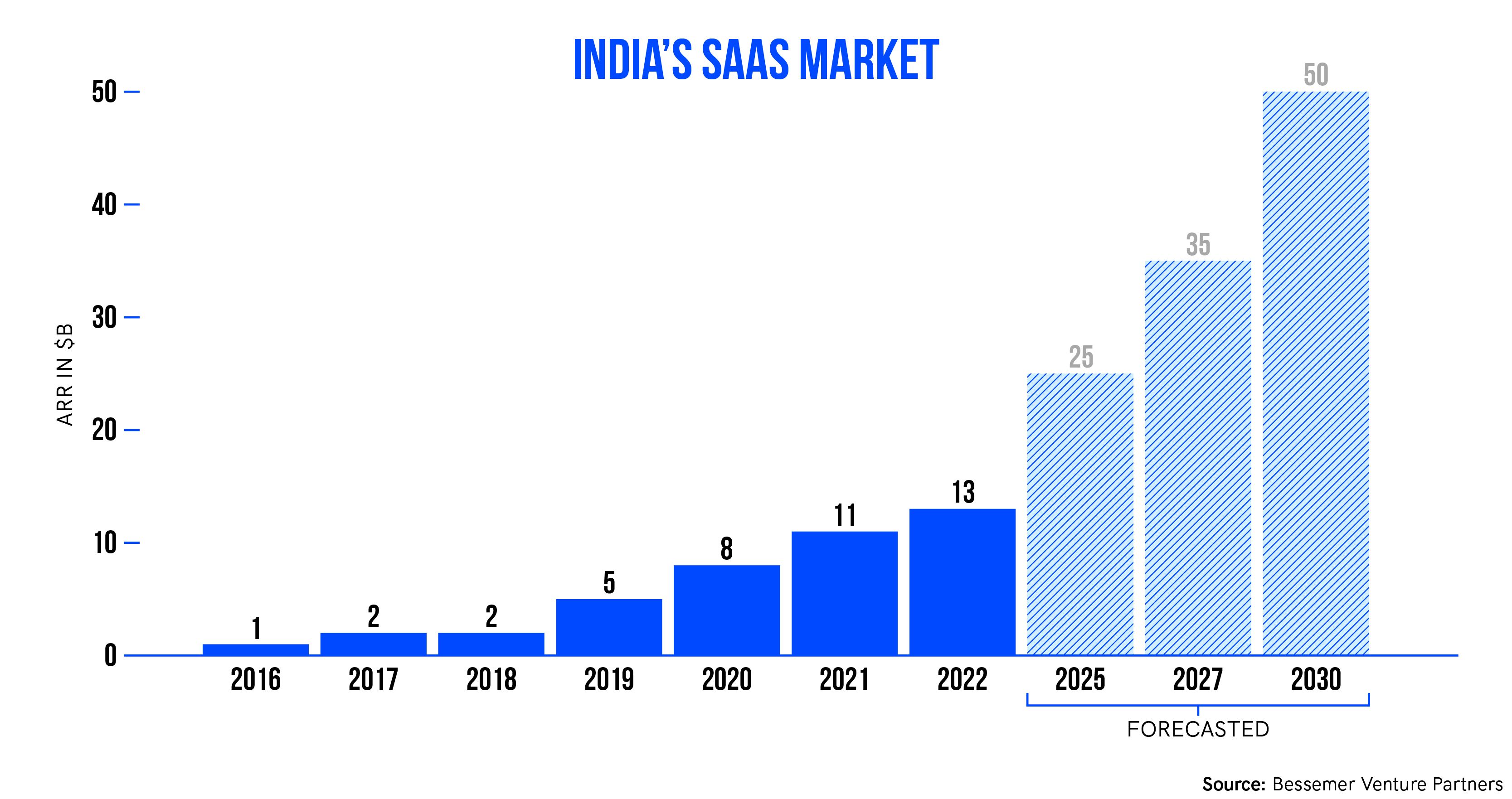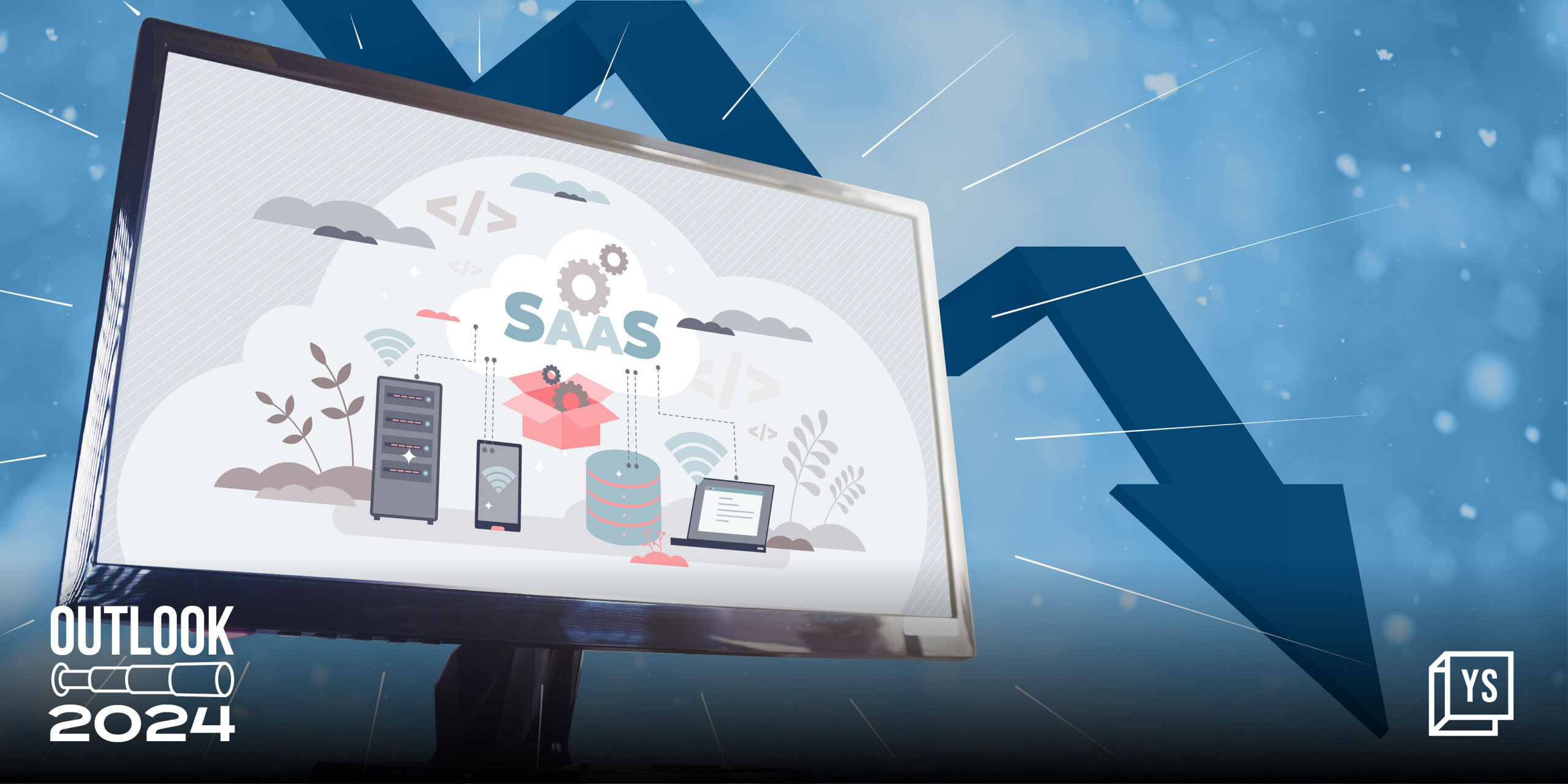
From artificial intelligence to automation, 2023 has been a year of both triumphs and setbacks. The Indian software-as-a-service (SaaS) industry has not only weathered economic downturns but has also stood tall amid the funding winter.
Projections paint a promising picture, with a joint report from and setting ambitious targets for India’s SaaS sector—a revenue range of $50-70 billion and an enterprise value of $500 billion by 2030.
Funding landscape
A total of 82 Indian startups were funded in the sector in 2023, according to the SaaS fund and accelerator .
According to YourStory Research, in 2022, there were a total of 182 deals totalling $1.89 billion. In 2023, the number of deals decreased to 111 with a funding size of $482.09 million.
<figure class="image embed" contenteditable="false" data-id="534371" data-url="https://images.yourstory.com/cs/2/fe056c90507811eea8de27f99b086345/SaaSFundingGraphic-01-1704200190142.jpg" data-alt="SaaS Funding, SaaS Outlook, YS Research," data-caption="
Comparing the number of deals in 2023 to 2022, YS Research
” align=”center”> Comparing the number of deals in 2023 to 2022, YS Research
Over the years, the zero-interest rate phenomenon (ZIRP, an RBI policy to stimulate economic activity) brought a significant influx of cash to startups, making them attractive opportunities for risk-taking investors. However, in 2023, as inflation set in, interest rates soared and the once abundant pool of cash for startups dried up.
However, Boston-based marketing automation firm Klaviyo’s September 2023 IPO offered a breath of fresh air. Founded by an Indian-origin entrepreneur, the firm raised $576 million through its public debut on the New York Stock Exchange. The milestone brought hope during a period of diminished tech valuations and boosted investor confidence.
<figure class="image embed" contenteditable="false" data-id="534375" data-url="https://images.yourstory.com/cs/2/fe056c90507811eea8de27f99b086345/SaaSFundingGraphic-031-1704201080332.jpg" data-alt="Top locations of SaaS Funding, SaaS deals," data-caption="
Prime SaaS funding hubs in 2023
” align=”center”> Prime SaaS funding hubs in 2023
Also, generative AI (GenAI) has become the new buzzword in the SaaS landscape too with startups such as Sarvam AI, employee experience platform , and small business-focused raising fresh capital.
“In addition to cloud tech becoming the norm, the generative AI wave has added more than $250 billion to the TAM (total addressable market),” says Manav Garg, CEO of Eka Software and Founding Partner at , in a conversation with YourStory.
Many late-stage companies are now assessing the adaptability of GenAI for various downstream applications. “If the new technology could potentially be a disruptor to the entire business, it is the right time to pivot now,” he adds.
VCs still see SaaS startups as promising long-term investment opportunities, says Anand Jain, Co-founder and Chief Product Office, .
“Despite recent turbulence, if founders prioritise building tangible value over just raising capital, investors will be attracted to the sector. First, because the SaaS business model (especially B2B) is inherently scalable. And second, external variables such as the rate of digital transformation globally and maturity of cloud computing only facilitate a more evolved SaaS ecosystem,” he explains.
Despite a 54% YoY drop in VC investments from 2022 to 2023, according to Upekkha, companies employing AI saw a significant uptick in funding. A Goldman Sachs report projected that global AI investments to potentially reach $200 billion by 2025, up from $21 billion in 2021.
.thumbnailWrapper
width:6.62rem !important;
.alsoReadTitleImage
min-width: 81px !important;
min-height: 81px !important;
.alsoReadMainTitleText
font-size: 14px !important;
line-height: 20px !important;
.alsoReadHeadText
font-size: 24px !important;
line-height: 20px !important;

Market expansion
Scalability, regular software updates, and flexible pricing models drive the SaaS market’s rapid expansion, contributing significantly to its growth globally and in India.
“The 2023 SaaS market in India is expected to grow at 23.7% compared to the worldwide average of 18%. This is because acceleration to the cloud is an emerging priority for Indian organisations as they are catching up with some of the more cloud-mature regions of the world,” says Amarendra, Sr Principal Research at Gartner.
India’s SaaS market is expected to reach $50 billion in annual recurring revenue (ARR) by 2030, as per a report by Bessemer.
There is an increase in the number of early-stage companies surpassing $10 million in revenue, signifying a robust foundation for expansion, says Anant Vidur Puri, Partner, .
<figure class="image embed" contenteditable="false" data-id="534373" data-url="https://images.yourstory.com/cs/2/fe056c90507811eea8de27f99b086345/SaaSFundingGraphic-05-1704200592268.jpg" data-alt="India SaaS market, Bessemer Venture Partner, " data-caption="
India’s SaaS market set to hit $50 billion ARR by 2030
” align=”center”> India’s SaaS market set to hit $50 billion ARR by 2030
“One distinctive advantage is observed in Indian software companies, which boast higher efficiency metrics compared to their global counterparts. Moreover, the prevailing high-interest rate environment further provides an edge to India’s SaaS businesses,” he notes.
Indian SaaS companies across horizontals and verticals continue to show strong growth momentum and a clear right to win in global markets, says Gustaf Ericson, Associate Partner, .
“This applies with even larger scale companies (>$20 million ARR), demonstrating a continued ability to sustain healthy ARR growth rates. While deal values remain well short of their peak in H1 2022, Indian SaaS investments remain resilient in proportion to the overall funding market—notably in VC,” says Ericson.
There has been support from both established Indian SaaS investors and new entrants, particularly at later stages with funding deals exceeding $30 million. Ecommerce solution provider Ace Turtle secured $34 million in its Series B funding round. Capillary Technologies, another SaaS startup, raised $45 million.
While Indian SaaS enterprises keep one foot in India, their outlook is global. India-centric firms like Perfios, Lentra, and Zopper primarily concentrate on the domestic market, while companies such as Zoho, Freshworks, and Entropik predominantly target customers worldwide.
Ericson believes that Indian SaaS companies are increasingly going “US-first” at an earlier stage when developing their go-to-market strategies, leveraging an established US growth playbook.
“The US remains critical as an end-market for Indian SaaS companies given its significantly larger scale (~$150 billion vs $2-3 billion for India),” he adds.
In contrast, while expanding to serve non-US markets, Garg believes that India and the Middle East in Asia are emerging as new hotspots given their proximity and understanding of these markets. However, diversity remains a major challenge. “A robust partner network is required for most companies to succeed in these regions,” he notes.
There is no dearth of funding for good companies, says CEO Sabyasachi Goswami. “Companies with robust fundamentals, marketable products poised for growth, and a well-crafted business model attract a loyal customer base,” he adds.
Industries or companies dedicated to profitable expansion are well-positioned for an IPO, with market conditions playing a crucial role, believes Ranjan Kumar, Co-founder and CEO, .
“Technology sectors, particularly B2B SaaS companies and AI-focused entities, excel in leveraging intellectual property differentiators and business predictability. This makes them strong contenders for the IPO path. Additionally, categories boasting high gross margins are more likely to successfully move in the direction of achieving this goal,” says Kumar.
.thumbnailWrapper
width:6.62rem !important;
.alsoReadTitleImage
min-width: 81px !important;
min-height: 81px !important;
.alsoReadMainTitleText
font-size: 14px !important;
line-height: 20px !important;
.alsoReadHeadText
font-size: 24px !important;
line-height: 20px !important;

Deeptech-driven productisation
According to an EY-NASSCOM report, 99% of Indian B2B SaaS companies profiled have embraced deeptech innovations. Zoho and Freshworks have employed a multi-product strategy to their advantage where each new product serves as a means to generate additional revenue from the same customer.
In September, Zoho surpassed $1 billion ARR without raising any external capital. It improved efficiency by introducing new products to the existing offerings and using engineering solutions to sell more to their current customers.
SoftBank-backed SaaS firm ‘s web adoption tool remained its core product offering till 2021, contributing 100% to the revenue.
“In the last 18 months, Whatfix has transitioned from a single-product company to a multi-product company. About 70% of the software is web-based and there are 25% software still on the desktop. Around 5-20% of software can be accessed on mobile,” says its CEO and Co-founder Khadim Batti.
The uptick in digital adoption stands to benefit SaaS companies in general, says Biswajeet Mahapatra, Principal Analyst at research and advisory firm Forrester.
“SaaS adoption has grown globally by 40% over the past year, with plans to grow similarly in the next coming years. Customer retention is not a major challenge although around 10-15% of customers are looking out for other options,” says Mahapatra.
Bessemer’s Anant believes India presents a significant opportunity for the “productisation of services”. “Cloud software developers will leverage AI to improve B2B service delivery, likely in the form of new tools or software-enabled marketplaces,” he adds.
Disrupting through GenAI
Generative AI has marked a massive technological shift, similar to the internet, cloud computing, and smartphones. In today’s context, large language models (LLM) serve as the modern counterpart to mobile operating systems.
According to ‘The SaaS Outlook 2023’ by Upekkha, the rise of LLM apps is pushing for a change in the underlying technology architecture and reshaping customer needs, making AI integration pivotal for SaaS companies. AI-first companies from India are set to lead the productisation of services locally and globally, says a joint report by SaaSBoomi and McKinsey, terming GenAI as a “watershed moment” for SaaS.
AI-focused investments are at the core of many new SaaS funds.
Together Fund launched Fund II earlier this year as a $150 million early-stage fund with an AI-first investment strategy. In December, SenseAI Ventures launched its inaugural venture capital fund, the SenseAI Fund I, with a target corpus of Rs 200 crore ($25 million) to invest in Indian AI startups.
“The SaaS ecosystem has to adapt to the change faster and those who do not tap into the opportunity or fail to pivot will find it even harder down the line. The year 2024 will be a make-or-break year if you are already not on the GenAI bandwagon,” adds Eka’s Garg.
“SaaS-proficient vendors can use the promise of GenAI to help overcome objections to SaaS adoption, but they also need to be flexible to meet Indian end users’ requirements for flexibility in contract terms and pricing,” notes Amarendra, Sr Principal, Research at Gartner.
GenAI also has the potential to impact every aspect of running a SaaS company. According to Ericson of Bain & Co, it includes a) product development enabled by access to LLM APIs, b) engineering with GenAI enhancing code generation, testing, and debugging, c) improved customer support through chatbots for an enhanced experience, and d) AI-tailored collateral for the go-to-market strategy.
Fighting macro conditions
‘s (SVB) collapse in March 2023 caused by a slump in investment value and withdrawals sparked anxiety among depositors. Indian founders, especially in the SaaS sector, were significantly affected. The US Federal Deposit Insurance Corporation intervened to safeguard depositor interests, overseeing the sale of SVB assets.
As per Upekkha’s report, private equity-backed deals increased from 58% in Q3 2022 to 60% in July-September 2023, with vertical SaaS businesses dominating the majority of all deals. According to data from Venture Intelligence, investors are more cautious due to macroeconomic pressures, leading to a notable decrease in the number of deals from 147 in the first half of 2022 to 70 in H1 2023.
Investments in the Indian SaaS sharply declined by almost 81% to $635 million in the first half of 2023 compared with the significant $3.4 billion raised during the same period in 2022.
In 2023, SaaS M&A continued to be at the forefront with key deals including Cisco’s acquisition of Splunk and Atlassian’s acquisition of Loom.
<figure class="image embed" contenteditable="false" data-id="534372" data-url="https://images.yourstory.com/cs/2/fe056c90507811eea8de27f99b086345/SaaSFundingGraphic-04-1704200405209.jpg" data-alt="Major SaaS Acquisitions in 2023" data-caption="
A recap of major SaaS deals in 2023
” align=”center”> A recap of major SaaS deals in 2023
Attracting attention from major players in the tech industry, startups such as industrial IoT-focused , fraud analytics solution provider , and AI-powered synthetic video creation platform were acquired by global giants , , and Adobe, respectively.
Ericson says SaaS companies in the US are seeing a decrease in valuation, however, the story is different back home. “We have not however seen a similar compression in India SaaS multiples given the lag effect between public and private valuations as well as the strong growth profiles of Indian SaaS companies,” he notes.
Platform-as-a-Service (PaaS) is expected to expand, offering developers a flexible platform for SaaS app creation. Moreover, SaaS platforms will prioritise mobile-first development as mobile usage rises.
India will continue to hold an edge over its global counterparts regarding go-to-market (GTM) strategies and capital efficiency.
(Cover image and infographics by Nihar Apte.)
Edited by Kanishk Singh










